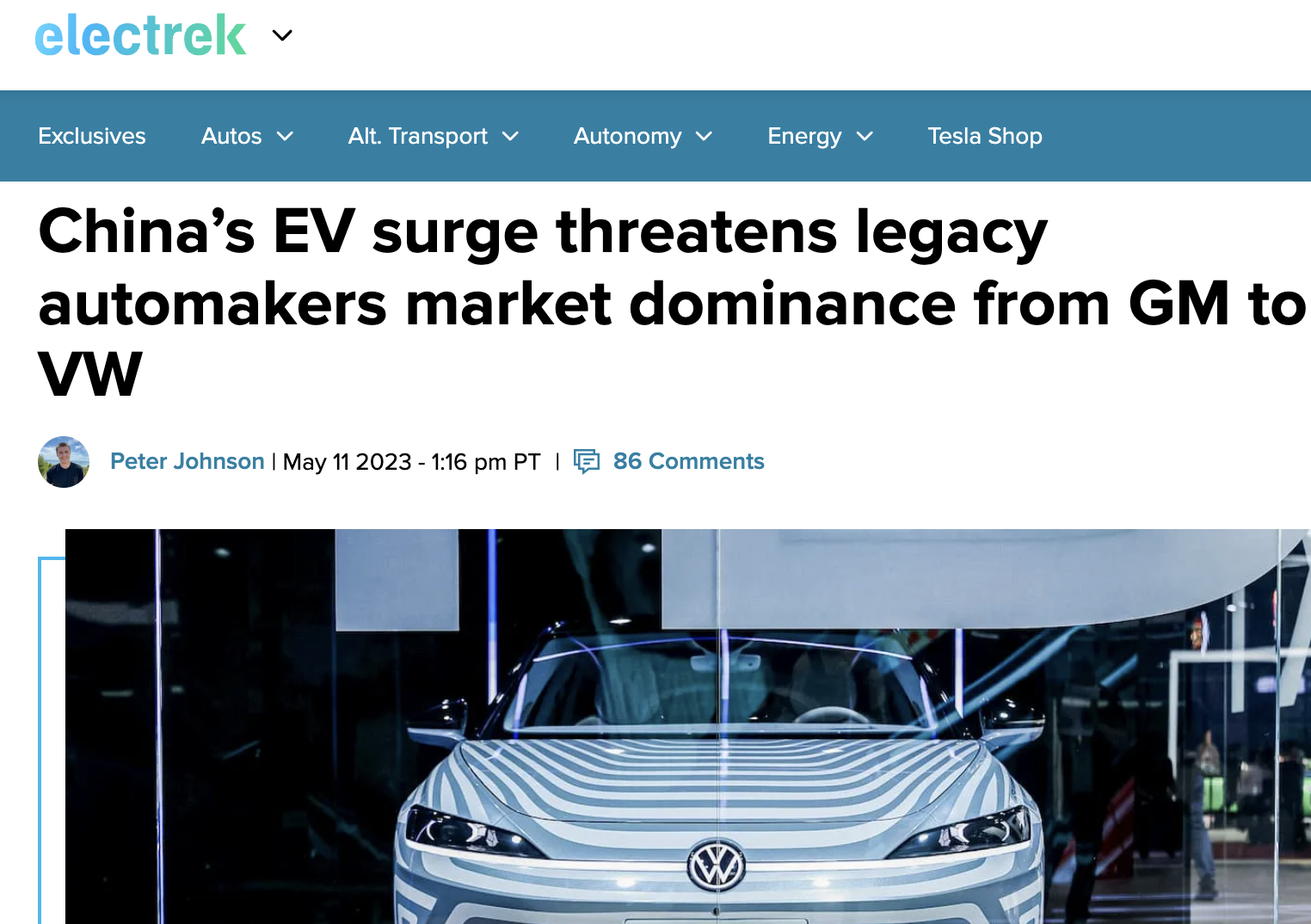Analyzing The Challenges: Why Western Automakers Struggle In The Chinese Market

Table of Contents
Intense Domestic Competition
The Chinese automotive market is fiercely competitive, primarily due to the meteoric rise of domestic brands.
Rise of Chinese Auto Brands
Chinese automakers like BYD, Nio, and Xpeng have rapidly gained market share, leveraging advanced technologies and appealing designs tailored specifically to Chinese consumer preferences. Their success isn't accidental; it's a result of strategic planning and substantial government support.
- Successful Chinese EV Models: BYD's Han and Tang EVs, Nio's ES8 and ET7, and Xpeng's P7 and G9 have become highly popular, offering competitive ranges, sophisticated features, and attractive pricing.
- Innovative Features: Chinese brands often incorporate cutting-edge technology, such as advanced driver-assistance systems (ADAS), large touchscreens with intuitive interfaces, and seamless smartphone integration, features highly valued by Chinese consumers.
- Government Support: Significant government subsidies and incentives for domestic electric vehicle (EV) manufacturers provide a significant competitive advantage.
Price Wars and Market Share Erosion
The aggressive pricing strategies employed by Chinese brands have triggered intense price wars, significantly impacting the profitability and market share of Western automakers.
- Examples of Price Wars: Several instances show Chinese brands undercutting Western competitors on price, especially in the burgeoning EV segment, forcing Western manufacturers to respond with price reductions, squeezing profit margins.
- Impact on Profit Margins: The pressure to compete on price has eroded profit margins for many Western automakers operating in China, making it challenging to justify further investment.
- Counter-Strategies: Western brands are attempting to counter this by focusing on premium segments, emphasizing brand prestige, and highlighting advanced technological features not offered by their lower-priced competitors.
Understanding Unique Consumer Preferences
Successfully navigating the Chinese automotive market requires a deep understanding of unique consumer preferences, which often differ significantly from those in Western markets.
Technological Preferences
Chinese consumers demonstrate a strong preference for technologically advanced vehicles, often surpassing that of consumers in other regions. This presents a challenge to Western brands that might lag in incorporating the latest technological innovations.
- Advanced Features: Features like advanced ADAS, sophisticated infotainment systems, and comprehensive connectivity features are highly sought after in China. The integration of these features with popular social media and payment platforms is also critical.
- Importance of Digitalization: Online sales channels and digital marketing are crucial in China, where a large proportion of car purchases are initiated and completed online. Western automakers need robust digital strategies to compete effectively.
Brand Perception and Marketing Strategies
Building a strong brand image and employing effective marketing strategies tailored to Chinese culture is paramount. Western brands often struggle with accurately communicating their brand message and resonate with local consumers.
- Successful and Unsuccessful Campaigns: While some Western brands have successfully adapted their marketing strategies for the Chinese market, others have struggled, highlighting the need for a deep understanding of cultural nuances.
- Local Partnerships: Collaborating with local partners can provide valuable insights into consumer preferences and help navigate the complexities of the Chinese market.
- Cultural Nuances in Advertising: Advertising campaigns need to be sensitive to cultural values and avoid potentially offensive or inappropriate messaging.
Regulatory Hurdles and Infrastructure Challenges
Navigating the complex regulatory landscape and addressing infrastructure challenges also pose significant obstacles for Western automakers in China.
Government Regulations and Policies
Stringent emission standards, safety regulations, and import tariffs create considerable hurdles for Western automakers operating in China.
- Specific Regulations: China has increasingly stringent emission regulations, pushing for greater adoption of electric and hybrid vehicles. Meeting these standards can significantly increase production costs.
- Navigating the Regulatory Landscape: Understanding and complying with the intricate regulatory framework requires specialized expertise and significant investment.
- Impact on Production Costs and Pricing: The regulatory environment directly impacts production costs and pricing, potentially reducing competitiveness.
Charging Infrastructure and Supply Chain Issues
The development of sufficient charging infrastructure for electric vehicles and the complexities of the Chinese supply chain represent further challenges.
- EV Charging Infrastructure: While significant progress has been made, the development of a comprehensive nationwide EV charging network is still ongoing, hindering widespread EV adoption.
- Supply Chain Challenges: Securing parts and materials within the Chinese supply chain requires establishing strong relationships with local suppliers and adapting to the unique dynamics of this complex network.
- Importance of Localization: Localizing production and sourcing components locally can mitigate supply chain risks and reduce costs, but this requires significant investment and strategic planning.
Conclusion
Western automakers face a formidable challenge in the Chinese market, with intense domestic competition, unique consumer preferences, and complex regulatory and infrastructural hurdles forming significant obstacles. The key takeaways highlight the necessity of adaptation; a deep understanding of the local market, including technological preferences, cultural nuances, and the regulatory environment, is crucial. To succeed in this dynamic market, thorough research and adaptation are crucial. Continue exploring the complexities of why Western automakers struggle in the Chinese market for a deeper understanding of this pivotal market. Understanding these struggles is the first step towards developing effective strategies for navigating the challenges of the Chinese automotive market and achieving sustainable success.

Featured Posts
-
 Pacers Vs Hawks Injury Report Game Day Update March 8th
May 28, 2025
Pacers Vs Hawks Injury Report Game Day Update March 8th
May 28, 2025 -
 Swiatek And Alcaraz Victorious In Roland Garros First Round
May 28, 2025
Swiatek And Alcaraz Victorious In Roland Garros First Round
May 28, 2025 -
 American Music Awards 2025 Swift And Beyonces Impressive Nomination Count
May 28, 2025
American Music Awards 2025 Swift And Beyonces Impressive Nomination Count
May 28, 2025 -
 Cities Under Siege Dangerous Climate Whiplash And Its Global Impact
May 28, 2025
Cities Under Siege Dangerous Climate Whiplash And Its Global Impact
May 28, 2025 -
 Is Nintendos New Era Too Safe Analyzing The Companys Conservative Approach
May 28, 2025
Is Nintendos New Era Too Safe Analyzing The Companys Conservative Approach
May 28, 2025
Latest Posts
-
 Man Overleden Na Schietpartij In Venlo
May 29, 2025
Man Overleden Na Schietpartij In Venlo
May 29, 2025 -
 Update Schietincident Op De Prinsenstraat In Venlo
May 29, 2025
Update Schietincident Op De Prinsenstraat In Venlo
May 29, 2025 -
 Venlo Recente Ontwikkelingen Rond Schietincident Prinsenstraat
May 29, 2025
Venlo Recente Ontwikkelingen Rond Schietincident Prinsenstraat
May 29, 2025 -
 Man Injured In Beacon Hill Shooting Police Investigate
May 29, 2025
Man Injured In Beacon Hill Shooting Police Investigate
May 29, 2025 -
 Prinsenstraat Venlo Onderzoek Na Schietincident
May 29, 2025
Prinsenstraat Venlo Onderzoek Na Schietincident
May 29, 2025
